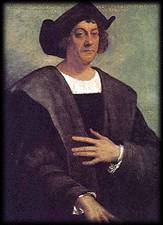
Even though Christopher Columbus was born in Genoa, Italy, his sea travels brought him to Lisbon, Portugal, where he settled with his married brother around 1479.
Based on the information of his travels, he believed that the earth was 25% smaller than thought, and composed mostly of land. Therefore, the fastest way to reach Asia would be by sailing westward across the Atlantic, skipping the longer route eastward. He submitted his theories in 1484 to John II, King of Portugal, petitioning him to finance an expedition across the Atlantic. The King passed on the petition to the Royal Maritime Commission, who rejected Columbus, due to other ships already rounding the tip of Africa at the time.
Columbus then moved to Spain, winning the support of many influential people for his plan, and petitioned to Queen Isabella of Castile, Spain. Even though a Royal Commission there also rejected his plan, he tried again in 1492, and was given their consent. Ferdinand and Isabella, King and Queen, agreed to sponsor the expedition, under the terms that Columbus would become viceroy of all the lands located, and that he could keep a tenth of all valuables found.
Columbus set sail from Palos de la Frontera, Spain, on August 3, 1492, with about 90 men, and three ships. The three ships were the Niņa, the Pinta, and the Santa Maria; Columbus would command the Santa Maria, the largest of the three ships. Once underway, they stopped briefly on the Canary islands to repair the Pinta’s mast. They set sail August 6 due West, but changed course on October 12 to a southwestern direction. The Crew was for many months unhappy with their captain, who seemed almost uncertain of where he was going. But things changed once signs of land appeared - land was sighted on October12, landing the ships on Guanahani, an island in the Bahamas. To an audience of islanders who did not understand Columbus, he claimed the land in the came of Spain, naming it San Salvador. Other landings were made on the islands of Cuba, (which he named Juana), Espaņola (which is now the Dominican Republic and Haiti) all mistakenly believed to be in Asian waters. After wrecking the Santa Maria off the coast of Espaņola, the crew used salvaged materials to build a makeshift fort there called La Navidad. They then sailed home, arriving in Spain March of 1493.
Columbus set out on a second expedition in September of 1493, where he landed on the island of Dominica, Guadeloupe, and Antigua. The closest he came to the U.S. was Puerto Rico, the foundation for him to have supposedly discovered "America." He surveyed the coast of Cuba, and looked over the island of Jamaica.
Columbus returned to Spain on September 29. He returned to the Americas after hearing of dissensions that had developed among colonists there, traveled there, but soon returned to Spain.
It wasn’t until two years after his return that he set sail for his third voyage on May 30, 1948. Landing on Trinidad on July 31, he also made some sightings from there, including Venezuela. He wrote in his logbook he had found a "New World", yet unknown to Europeans. He encountered more islands, including Margarita, then set course for Espaņola. The crew arrived at Santo Domingo, to find a colony in chaos and revolt. Trying to settle things, his enemies in Spain convinced monarchs to give the colony a new governor, Francisco de Bobadillo. Francisco arrived in Espaņola in 1500, and upon his arrival, sent Columbus home in shackles. When Columbus arrived, he appealed of course to the shackles, and was pardoned, but was not allowed to return to Espaņola as governor.
Columbus gained support once again for another voyage, his fourth, but was prohibited from stopping in Espaņola, and was given ships that were already in poor condition. He sailed the waters off the coast of Honduras, then cruised along the coast of Central America for six months still in search of a passage westward. He landed in Panama, establishing a temporary settlement there, then sailed back to Espaņola. The poor ships he was given did not make it past Jamaica, nevertheless to Espaņola, so he sent for help. In the meanwhile, he landed on Jamaica, and forced the natives there to give food to his crew members. Help would not come for a year, done so on purpose by his adversary, the new governor of Espaņola who had taken the place of Columbus. They did receive help though sooner or later, and embarked on June 28, 1504 for Santo Domingo, then directly for Spain. Columbus and the crew arrived in Spain on November 7. Columbus never sailed again.
Columbus’ final months of life were with illness, dying on May 20, 1506, at Valladolid, Spain.
Sites for further Information
"Topical Philately:
Christopher Columbus"
http://www.geocities.com/TheTropics/4131/cc.htm
"Medieval Sourcebook:
Christopher Columbus: Extracts from Journal"
http://www.fordham.edu/halsall/source/columbus1.html
"The Discovery of America"
http://www.DocuWeb.ca/SiSpain/english/history/discover.html
"1942: An Ongoing Voyage"
http://sunsite.unc.edu/expo/1492.exhibit/Intro.html